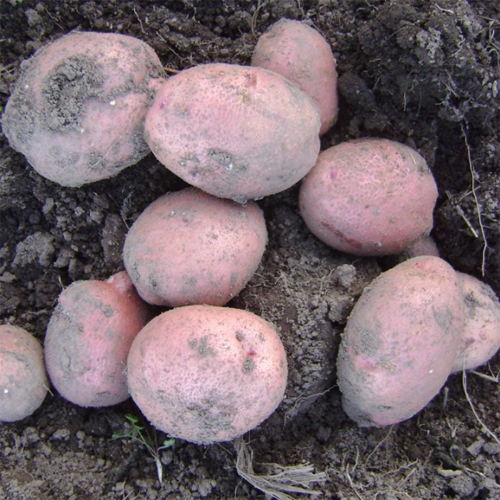Potato variety Hostess
Hostess is a mid-season Russian potato variety (Solanum tuberosum) for table use. Bred by specialists of the Siberian Research Institute of Agriculture. To obtain, the varieties Santa and Zarevo were used. In 2009, 4 years after the filing of the application, it was included in the state register of breeding achievements of the Russian Federation. Zoned in two regions: West Siberian (Altai Republic and Altai Territory, Kemerovo, Novosibirsk, Omsk, Tomsk, Tyumen Regions) and East Siberian (Republics of Buryatia, Sakha (Yakutia), Tyva, Khakassia, Irkutsk Region, Krasnoyarsk and Transbaikal Territories ). The variety is suitable for processing into chips. Differs in good adaptation to soil and climate, resistance to drought and mechanical damage.
The plant is tall, spreading, of an intermediate type, the amount of green mass is medium. Stems are semi-erect, strongly branched, angular in cross section. Anthocyanin coloration is observed in the leaf axils. The leaf plate is large, open type, dark green in color, strongly wavy at the edges. Corolla reddish purple with white tips. The intensity of the anthocyanin coloration of the bud is weak. The inflorescence is compact, few-flowered. Flowering is moderately abundant, short-lived, berries are rarely formed during self-pollination.

In one nest of potatoes, an average of 8-14 rather large tubers are formed, each weighing 101-179 grams, very few small ones. The tubers have an oval-rounded shape, a flat surface. The peel is slightly reticulate, red. The pulp is white or light creamy. The eyes are small, numerous, shallow, colored red, sometimes they can stand out against the general background. Sprouts are dark red-violet in color.
According to the results of state tests, the marketable yield of the Hostess was recorded in the range of 178−355 kg / ha, at the level of indicators of the Nakra and Lugovskoy... The maximum amount was collected in the Omsk region - 383 c / ha, 131 c / ha more than the Lugovskoy standard. The marketability of tubers is at a high level - 87−97%, keeping quality is also excellent - 95%.
This potato tastes very good, even great! The pulp is very mealy, with a high starch content (17-19%), does not darken during heat treatment and cutting. The tubers are suitable for preparing absolutely any dishes, and are especially good in mashed potatoes, ideal for processing into chips. The originator provides the following data on the content of substances in the pulp: reducing sugars - 0.05-0.3%, vitamin C - 16-22 mg%.
The variety is perfectly adapted to the harsh Siberian and Ural conditions, undemanding to soils. Plants respond very well to mineral fertilization. They are drought tolerant, but respond well to irrigation. It is strongly recommended to germinate the tubers before planting, but you should not cut them. Otherwise, the Hostess is simple in agricultural technology and does not require any special attention. However, one more thing can be noted - do not delay harvesting and observe crop rotation on the site, since potatoes are prone to late blight. Also, under unfavorable conditions, tubers may crack during growth.
The species is highly resistant to viruses, cancer, and aureus cyst nematode. Medium resistant to early dry spotting, rhizoctoniae, common scab, late blight on tubers. The tops of the late blight pathogen are more susceptible.
The gardeners are very fond of the Hostess for his stability and unpretentiousness to growing conditions - even in the worst seasons, he gives good yields of fairly large tubers.Also appreciated are its taste, keeping quality, drought resistance, excellent presentation of tubers and their resistance to mechanical damage, and, of course, high yield. There are very few disadvantages of this potato, the main one is the relative vulnerability to late blight. Otherwise, this variety can be called the most reliable for the Siberian region.








